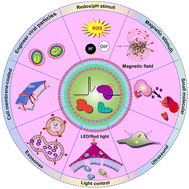Biomaterial-assisted targeted and controlled delivery of CRISPR/Cas9 for precise gene editing
Abstract
RISPR-Cas9 has exhibited enormous potential in gene therapy. It can perform genome editing with single-nucleotide precision in various types of cell and tissue, providing a powerful breakthrough technology for genome editing in therapeutic development. But the limited delivery methods pose substantial challenges pertinent to safe and effective CRISPR/Cas9 delivery, thus hindering its application. These challenges should be tackled to develop next-generation genetic therapies. Biomaterial-based drug delivery systems can overcome these issues, for example using biomaterials as carriers for CRISPR/Cas9 targeted delivery, and conditional control of its function can improve precision, furnish on-demand and transient gene editing and reduce adverse consequences such as off-target events and immunogenicity, representing a promising direction for modern precision medicine. This review describes the application status and research progress of current CRISPR/Cas9 delivery approaches, including polymeric nanoparticles, liposomes, extracellular vesicles, inorganic nanoparticles and hydrogels. The unique properties of light-controlled and small-molecule drugs for spatially and temporally controlled genome editing are also illustrated. In addition, targetable delivery vehicles for the active delivery of CRISPR systems are also discussed. The perspectives to overcome the current limitations in the CRISPR/Cas9 delivery and their bench-to-bedside translation are also highlighted.

- This article is part of the themed collections: Biomaterials Science Recent HOT Articles and CRISPR Biomaterials


 Please wait while we load your content...
Please wait while we load your content...